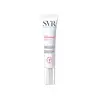What's inside
What's inside
 Key Ingredients
Key Ingredients

 Benefits
Benefits

 Concerns
Concerns

 Ingredients Side-by-side
Ingredients Side-by-side

Water
Skin ConditioningButyrospermum Parkii Butter
Skin ConditioningCocos Nucifera Oil
MaskingGlycerin
HumectantHexyldecyl Stearate
EmollientCaprylic/Capric Triglyceride
MaskingBehenyl Alcohol
EmollientSodium Acrylates Copolymer
Borago Officinalis Seed Oil
EmollientCetearyl Alcohol
EmollientCetearyl Glucoside
EmulsifyingGlyceryl Stearate Se
EmulsifyingGlycolipids
Skin ConditioningGlycosphingolipids
EmollientLecithin
EmollientMaltodextrin
AbsorbentOphiopogon Japonicus Root Extract
Skin ConditioningPentaerythrityl Tetra-Di-T-Butyl Hydroxyhydrocinnamate
AntioxidantSodium Stearoyl Glutamate
CleansingSodium Hyaluronate
Humectant1,2-Hexanediol
Skin ConditioningCaprylyl Glycol
EmollientCitric Acid
BufferingPentylene Glycol
Skin ConditioningWater, Butyrospermum Parkii Butter, Cocos Nucifera Oil, Glycerin, Hexyldecyl Stearate, Caprylic/Capric Triglyceride, Behenyl Alcohol, Sodium Acrylates Copolymer, Borago Officinalis Seed Oil, Cetearyl Alcohol, Cetearyl Glucoside, Glyceryl Stearate Se, Glycolipids, Glycosphingolipids, Lecithin, Maltodextrin, Ophiopogon Japonicus Root Extract, Pentaerythrityl Tetra-Di-T-Butyl Hydroxyhydrocinnamate, Sodium Stearoyl Glutamate, Sodium Hyaluronate, 1,2-Hexanediol, Caprylyl Glycol, Citric Acid, Pentylene Glycol
Water
Skin ConditioningPropanediol
SolventHydrogenated Polydecene
EmollientC15-19 Alkane
SolventOrbignya Oleifera Seed Oil
EmollientPolyacrylamide
Behenyl Alcohol
EmollientCaprylic/Capric Triglyceride
MaskingDipotassium Glycyrrhizate
HumectantSaccharide Isomerate
HumectantSodium Hyaluronate
HumectantTocopheryl Acetate
Antioxidant1,2-Hexanediol
Skin ConditioningC13-14 Isoparaffin
EmollientCaprylyl Glycol
EmollientCeteareth-20
CleansingCitric Acid
BufferingGossypium Herbaceum Seed Oil
Skin ConditioningLaureth-7
EmulsifyingPentylene Glycol
Skin ConditioningSodium Citrate
BufferingSodium Polyacrylate Starch
AbsorbentWater, Propanediol, Hydrogenated Polydecene, C15-19 Alkane, Orbignya Oleifera Seed Oil, Polyacrylamide, Behenyl Alcohol, Caprylic/Capric Triglyceride, Dipotassium Glycyrrhizate, Saccharide Isomerate, Sodium Hyaluronate, Tocopheryl Acetate, 1,2-Hexanediol, C13-14 Isoparaffin, Caprylyl Glycol, Ceteareth-20, Citric Acid, Gossypium Herbaceum Seed Oil, Laureth-7, Pentylene Glycol, Sodium Citrate, Sodium Polyacrylate Starch
 Reviews
Reviews

Ingredients Explained
These ingredients are found in both products.
Ingredients higher up in an ingredient list are typically present in a larger amount.
1,2-Hexanediol is a synthetic liquid and another multi-functional powerhouse.
It is a:
- Humectant, drawing moisture into the skin
- Emollient, helping to soften skin
- Solvent, dispersing and stabilizing formulas
- Preservative booster, enhancing the antimicrobial activity of other preservatives
Behenyl Alcohol is a type of fatty alcohol (these are different from the drying, solvent alcohols).
Fatty Alcohols have hydrating properties and are most often used as an emollient or to thicken a product. They are usually derived from natural fats and oils; behenyl alcohol is derived from the fats of vegetable oils.
Emollients help keep your skin soft and hydrated by creating a film that traps moisture in.
In 2000, Behenyl Alcohol was approved by the US as medicine to reduce the duration of cold sores.
Learn more about Behenyl AlcoholThis ingredient is an emollient, solvent, and texture enhancer. It is considered a skin-softener by helping the skin prevent moisture loss.
It helps thicken a product's formula and makes it easier to spread by dissolving clumping compounds.
Caprylic Triglyceride is made by combining glycerin with coconut oil, forming a clear liquid.
While there is an assumption Caprylic Triglyceride can clog pores due to it being derived from coconut oil, there is no research supporting this.
Learn more about Caprylic/Capric TriglycerideCaprylyl Glycol is a humectant and emollient, meaning it attracts and preserves moisture.
It is a common ingredient in many products, especially those designed to hydrate skin. The primary benefits are retaining moisture, skin softening, and promoting a healthy skin barrier.
Though Caprylyl Glycol is an alcohol derived from fatty acids, it is not the kind that can dry out skin.
This ingredient is also used as a preservative to extend the life of products. It has slight antimicrobial properties.
Learn more about Caprylyl GlycolCitric Acid is an alpha hydroxy acid (AHA) naturally found in citrus fruits like oranges, lemons, and limes.
Like other AHAs, citric acid can exfoliate skin by breaking down the bonds that hold dead skin cells together. This helps reveal smoother and brighter skin underneath.
However, this exfoliating effect only happens at high concentrations (20%) which can be hard to find in cosmetic products.
Due to this, citric acid is usually included in small amounts as a pH adjuster. This helps keep products slightly more acidic and compatible with skin's natural pH.
In skincare formulas, citric acid can:
While it can provide some skin benefits, research shows lactic acid and glycolic acid are generally more effective and less irritating exfoliants.
Most citric acid used in skincare today is made by fermenting sugars (usually from molasses). This synthetic version is identical to the natural citrus form but easier to stabilize and use in formulations.
Read more about some other popular AHA's here:
Learn more about Citric AcidPentylene glycol is typically used within a product to thicken it. It also adds a smooth, soft, and moisturizing feel to the product. It is naturally found in plants such as sugar beets.
The hydrophilic trait of Pentylene Glycol makes it a humectant. As a humectant, Pentylene Glycol helps draw moisture from the air to your skin. This can help keep your skin hydrated.
This property also makes Pentylene Glycol a great texture enhancer. It can also help thicken or stabilize a product.
Pentylene Glycol also acts as a mild preservative and helps to keep a product microbe-free.
Some people may experience mild eye and skin irritation from Pentylene Glycol. We always recommend speaking with a professional about using this ingredient in your routine.
Pentylene Glycol has a low molecular weight and is part of the 1,2-glycol family.
Learn more about Pentylene GlycolSodium Hyaluronate is hyaluronic acid's salt form. It is commonly derived from the sodium salt of hyaluronic acid.
Like hyaluronic acid, it is great at holding water and acts as a humectant. This makes it a great skin hydrating ingredient.
Sodium Hyaluronate is naturally occurring in our bodies and is mostly found in eye fluid and joints.
These are some other common types of Hyaluronic Acid:
Learn more about Sodium HyaluronateWater. It's the most common cosmetic ingredient of all. You'll usually see it at the top of ingredient lists, meaning that it makes up the largest part of the product.
So why is it so popular? Water most often acts as a solvent - this means that it helps dissolve other ingredients into the formulation.
You'll also recognize water as that liquid we all need to stay alive. If you see this, drink a glass of water. Stay hydrated!
Learn more about Water